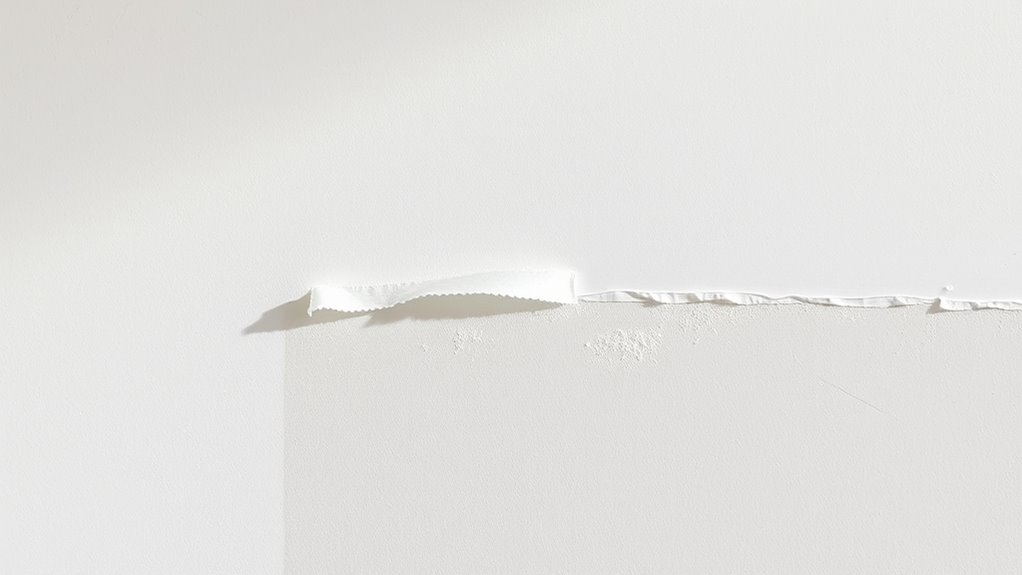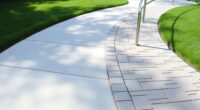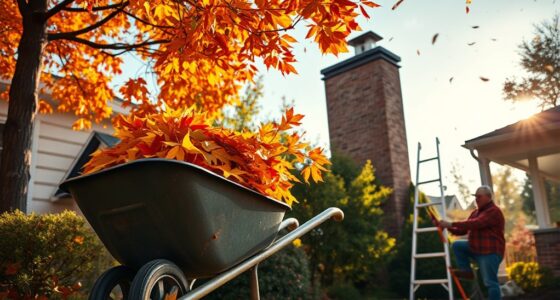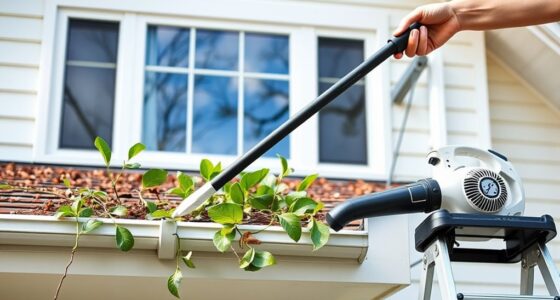To guarantee your paint lasts, don’t skip surface cleaning, repairing, sanding, or priming. Dirt, grease, and imperfections can cause peeling and uneven coverage, while neglecting priming leads to poor adhesion and color inconsistencies. Proper preparation also involves controlling humidity and environment. Skipping these steps might save time now, but it will cost you later with chipped, faded, or cracked paint. Keep going, and you’ll discover how these essential prep steps make all the difference.
Key Takeaways
- Skipping thorough cleaning can cause poor adhesion and premature peeling.
- Neglecting surface repairs and sanding results in visible flaws and uneven paint finish.
- Omitting primer leads to uneven color, reduced durability, and frequent touch-ups.
- Painting without proper ventilation and humidity control increases bubbles, streaks, and peeling risks.
- Foregoing comprehensive prep steps shortens paint lifespan and diminishes overall finish quality.
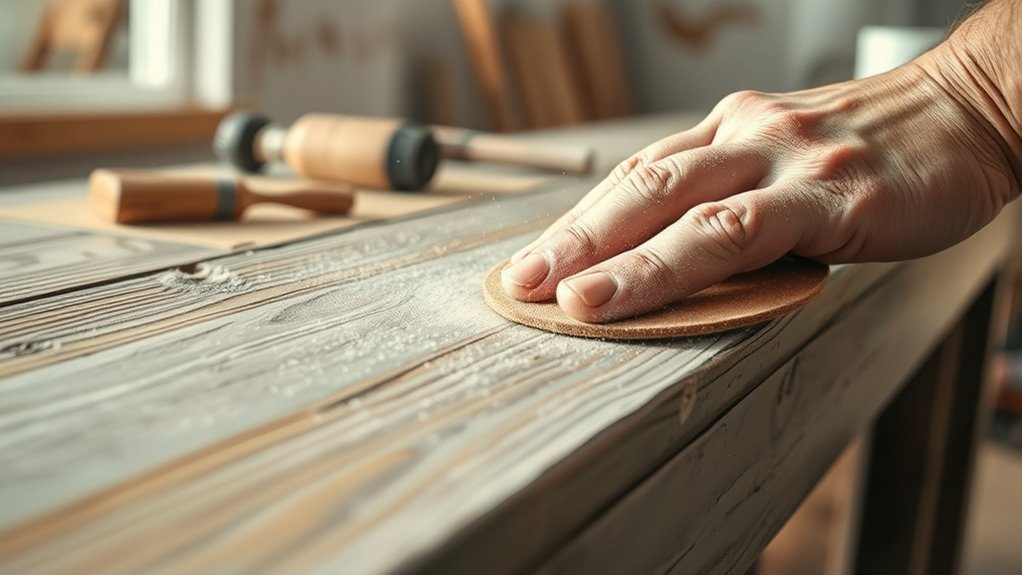
Paint That Lasts
When choosing paint, durability is key to ensuring your walls stay vibrant and looking fresh for years. But even the best paint won’t last if you skip essential preparation steps. Many homeowners underestimate how crucial proper prep work is and jump straight into painting, only to find their efforts don’t hold up over time. If you want your walls to look professional and last, you need to invest time into the prep process.
First, you should thoroughly clean the surfaces you plan to paint. Dirt, grease, and dust can prevent paint from adhering properly, leading to peeling or uneven coverage. Use a mild detergent or a specialized cleaner depending on the surface. Rinse well and let it dry completely before moving on. Skipping this step might seem small, but it can cause paint to bubble or peel prematurely.
Next, inspect the walls for any damage, such as holes, cracks, or peeling paint. Filling these imperfections with a suitable filler and sanding smooth creates a uniform surface that will hold paint better. If you ignore repairs, the flaws will become more noticeable over time, and the paint might crack or peel around them. Sanding is equally essential; it roughens the surface slightly, helping the new paint to grip securely. Forgetting to sand or rushing through this step can result in an uneven finish or early deterioration.
Priming is another step many overlook, but it’s indispensable for durability. Primer creates a uniform base, seals porous surfaces, and enhances the paint’s adhesion. If you’re painting over a dark color, stained walls, or glossy surfaces, primer prevents bleed-through and ensures the new paint color appears true. Skipping primer might save time initially, but it often leads to uneven color, reduced longevity, or the need for multiple coats.
Additionally, understanding and following proper painting techniques can significantly impact the longevity of your paint job. Finally, make sure your environment is prepared. Keep windows open for ventilation, and control humidity levels to prevent moisture from affecting the paint’s curing process. If you paint in high humidity or extreme temperatures, your work might not dry properly, leading to bubbles, streaks, or peeling down the line. Preparing your workspace and timing your project correctly can make a big difference in the paint’s lifespan.
In essence, skipping these prep steps is a shortcut that can cost you more time and money later. Proper cleaning, repairing, sanding, priming, and environmental control are what transform a simple coat of paint into a lasting finish. Take the extra time now, and your walls will thank you with vibrant, enduring beauty.
Frequently Asked Questions
How Long Should I Wait Between Primer and Paint Application?
You should wait at least 24 hours after applying primer before painting over it. This guarantees the primer fully dries and adheres properly, giving you a smooth, long-lasting finish. If the primer feels tacky or isn’t fully dry to the touch, give it more time. Always check the manufacturer’s instructions on the primer container for specific drying times, as they can vary based on conditions and product type.
Can I Skip Sanding if the Surface Looks Smooth?
You can skip sanding if the surface looks smooth, but don’t skip it just because it appears fine. Skipping sanding can leave tiny imperfections that cause paint to peel or chip prematurely. Take a moment to lightly sand—this boosts adhesion and ensures a flawless finish. Skipping this step might save time now, but it could cost you durability and a professional look later. Better to prep right and enjoy lasting results.
What Type of Cleaning Products Are Best Before Painting?
You should use a mild detergent or a specialized cleaner designed for the surface you’re painting. For walls, a solution of water and a few drops of dish soap works well. For greasy or dirty surfaces, consider trisodium phosphate (TSP) or a vinegar-water mix. Always rinse thoroughly with clean water afterward to eliminate any residue. Proper cleaning ensures your paint adheres well and lasts longer.
Is It Necessary to Use a Primer on Already Painted Walls?
Yes, you should use a primer on already painted walls, especially if you’re changing colors or the existing paint is stained or glossy. Primer helps the new paint adhere better, evens out surface porosity, and prevents color bleed-through. Skipping this step can lead to uneven results, peeling, or chipping over time. Investing in a good primer guarantees your paint job lasts longer, looks professional, and saves you time and effort in the long run.
How Do Environmental Conditions Affect Paint Durability?
When you paint in harsh weather, you might notice your walls don’t stay vibrant as long. Extreme heat, cold, humidity, or dampness can weaken paint’s bond and cause peeling or fading sooner. To guarantee your effort lasts, try to paint during mild, dry conditions. Properly preparing the surface and choosing weather-appropriate paint can shield your walls from nature’s unpredictable moods, helping your beautiful work stand the test of time.
Conclusion
Skipping proper prep is like building a house on shifting sands—you might get by for a while, but cracks will eventually appear. When you take the time to clean, sand, and prime, you’re laying a solid foundation that makes your paint shine like a freshly polished gem, vibrant and enduring. Think of your walls as a blank canvas ready to tell a story—give it the care it deserves, and your masterpiece will last for years to come.
